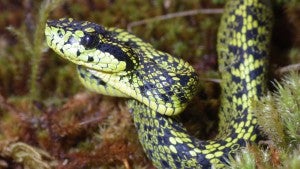An international team of scientists has solved a case of mistaken identity and discovered a new species of venomous snake.
The newly discovered Talamancan Palm-Pitviper is a striking green-and-black snake living in some of the most remote regions of Costa Rica. The coloring is a characteristic it shares with its close relative the Black-Speckled Palm-Pitviper. In fact, these two species look so similar that the Talamancan Palm-Pitviper went unrecognized for more than 100 years. It is a case of cryptic speciation, where two species look almost identical, but are genetically different.
“It’s a really interesting phenomenon,” said University of Central Florida biologist and professor Christopher Parkinson who led the team that made the discovery. “It shows some of the complexities we deal with when cataloging biodiversity and underscores the importance of maintaining natural-history collections. Discovering this species would not have been possible without the specimens housed in natural-history museums.”
The team’s findings are published in this the July 15 online issue of the academic journal Zootaxa.
The team first discovered evidence of the new species in 2001 during a genetic analysis of the palm-pitviper clade. Parkinson, an expert in venomous snakes, and his graduate students noticed some unusual genetic differences among the snakes they were studying. They began questioning if they could have a distinct new species on their hands. However, these snakes live at high elevations, in low densities and are rare even in their natural habitat, making it difficult to find the samples needed for thorough comparisons.
To overcome this, Tiffany Doan, first author on the paper, turned to the University of Texas at Arlington’s Amphibian and Reptile Discovery Research Center, the Museo Zoología at the Universidad de Costa Rica, and several other museums across the country to generate the morphological data used in the project. These institutions house natural-history collections containing thousands of reptile specimens from decades of research. They gave Doan and her colleagues the ability to compare morphology of the suspect snakes to those of others, which had been placed in museum collections for 150 years. During the past 15 years, the team also amassed tissue samples from additional specimens to compare the DNA of the potentially new snake species to the DNA from other snakes in Central America. Their findings concluded that the snake was indeed a new species.
Although many parts of Costa Rica are well explored and the nation has invested in documenting its biodiversity, new species continue to be discovered.
“This discovery highlights the necessity for strong conservation initiatives,” Parkinson said. Many undisturbed areas around the world are being developed before scientists get a chance to document their flora and fauna. “There’s no telling what other species are yet to be found and how they might benefit mankind.”
In the case of venomous species like the Talmancan Palm-Pitviper and Black-Speckled Palm-Pitviper, those benefits may be closer than we realize. Snake venoms have proven to be a great source for protein discovery and drug development. While little is known above the venom of the Talamancan Palm-Pitviper, the Black-Speckled Palm-Pitviper was recently shown to possess an important toxin that poses an interesting evolutionary question. The toxin, called nigroviriditoxin, is similar to a neurotoxin found in some rattlesnakes and hasn’t been seen in a nonrattlesnake before.
So did the toxin evolve in a common ancestor, or did these snakes independently develop the same toxin?
“It’s certainly an interesting question, because it gets at some of the fundamental concepts in evolution” said Ph.D. student Andrew Mason.
Mason was part of the team describing the new species and his dissertation work will focus on learning how evolution has shaped the venoms of palm-pitviper species. “We are really interested in seeing how the venom of this new species compares to other palm-pitvipers, and especially the Black-Speckled Palm-Pitviper because they are morphologically very similar.”

Newly discovered Talamancan Palm-Pitviper.
Talamancan Palm-Pitvipers are small to medium sized pitvipers that are relatively slender. They are found in trees where their green and black pattern provides excellent camouflage. A large snake might reach about 30 inches, but most are less than 24 inches. Scientists believe their habitat to include only 100 km area in the north of the Talamancan Cordillera of Costa Rica.
“The discovery of this new cryptic species shows the advantages of using modern molecular techniques and phylogenetic reconstructions in the catalog of the planet’s biodiversity,” said Mahmood Sasa, professor at the Instituto Clodomiro Picado, a toxin research center and producer of snake antivenin from Universidad de Costa Rica and a co-author of the research paper. “This research is a good example of the synergies that result from collaborative studies between institutions and countries, each party contributing with their own expertise to achieve common goals.”
The research team includes: Tiffany M. Doan and Andrew J. Mason from the University of Central Florida; Todd A. Castoe from the University of Texas at Arlington, and Mahmood Sasa from the Universidad de Costa Rica and Palo Verde Biological Station run by the Organization for Tropical Studies in San Jose, Costa Rica. The National Science Foundation partially funded this project.